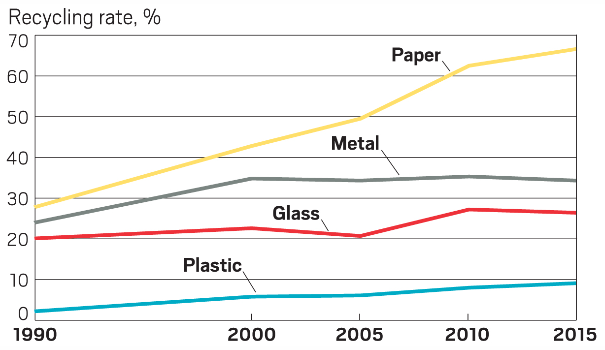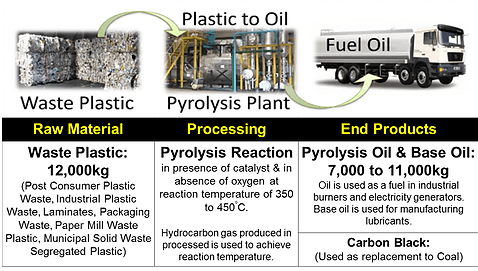The modern plastics industry is a great hallmark of global progress. Just look around at plastics use in life-saving medical products, lightweight transportation vehicles, and food waste saving barrier packaging to name a few milestones. However, the plastics industry needs to do more in terms of material recycling in general and particularly with regard to plastic recycling.
Roughly 10% or 35 Million Tons of plastics in the United States and 15% or 30 Million Tons in Europe are recycled. The most recently available US Environmental Protection Agency data bears this trend out over the past several years.
 US Environmental Protection Agency Material Recycling Rate
US Environmental Protection Agency Material Recycling Rate
There is basically an ongoing dysfunction in plastics recycling. In the United States, most plastics end up in landfills or incinerators, whereas 60% of all paper, 30% of metals, and 20% of the glass are recycled yearly. Yet cradle to grade plastics, particularly in packaging applications are very conservatively 4-6 times more energy efficient for equivalent package size.
The argument is and always will be compelling that plastics are a resource too valuable to waste.
So, let’s take a look at plastics recycling technologies that will define our sustainable future!
The key range of technologies that will define future
plastics circular economy success are:
- Mechanical Recycling
- PET (PolyEthylene Terephthalate) Depolymerization
- Pyrolysis
- Solvent-based Recycling
None of these technologies will dominate, as they will be subject to market
conditions and public policy over time.
Mechanical Recycling
Mechanical recycling is the most familiar and dominant form of recycling to the general public. It’s simple in design and inexpensive to operate. Yet it is particularly
sensitive to price dips in plastics waste. With China’s recent and ongoing imposed ban on importing plastics waste roughly half the global demand has disappeared.
This process is costly and technically inefficient with contaminated or mixed plastic waste. It will remain the global plastic materials recycling
technology of choice and experience
capacity expansions
accompanied by increased competition with short-term positive profitability challenges.

GreenWaste Mechanical Recycling Material Recovery Facility (MRF)
PET (PolyEthylene Terephthalate) Depolymerization
PET depolymerization is a very efficient plastic recycling technology that converts
PET (PolyEthylene Terephthalate) into its basic monomer starting points namely:
- DiMethyl Terephthalate (DMT)
- MonoEthylene Glycol (MEG)
This process will assist the long term in
recycling PET used in beverage and water bottles and will lead to high recycle content (25-40%) containers in these applications 3-5 years out. However, it is currently three times more expensive than mechanical recycling.
Also, it is dependent on a
low-cost PET flake regrind in harness with patented formulations currently under development at major bottle developers like
Coca-Cola and
Pepsi. Overall PET depolymerization will remain an important but niche recycling technology long term.
Loop Industries PET Depolymerization Process
Pyrolysis
Pyrolysis is derived from the Greek word, “
pyro” which means
heat and “
lysis” means
to break down. It finds use as a recycling technique with mixed plastic waste streams, totally not adaptable to mechanical recycling.
Although
energy-intensive by nature, pyrolysis fills the preceding gap best when oil prices are decreasing and as its distillation streams are targeted towards higher value-added chemical products, further insulating it from market price fluctuations. Roughly speaking with economies of scale, every ton of mixed plastic waste will yield approximately four barrels of pyrolysis oil.
 Agile Process Chemicals LLP (APChemi) Pyrolysis Technology
Agile Process Chemicals LLP (APChemi) Pyrolysis TechnologySolvent-based Recycling
Solvent-based recycling is another
emerging alternative to dispose of mixed plastic waste not handleable by mechanical recycling.
- Its operational niche is post-industrial, mixed plastic waste where contamination challenges are not relevant, as is the case in post-consumer plastic waste.
- Also, its primary limitation is a very heavy dependence on solvent costs that in turn will limit its market growth.
Fraunhofer IVV CreaSolv Solvent-based Recycling Process
Conclusion
None of the preceding four major plastic materials recycling technologies will totally dominate in the marketplace.
Rather plastic waste and type of waste availability by given global geography will dictate the specific recycling technology mix. For the foreseeable future, a combination of recycling technologies will be in use.
In any global geographic region, where efficiently sorted, higher quality, and potentially clear plastic waste is available, it will be best matched by lower-cost mechanical recycling. Limited polypropylene and polystyrene plastic waste streams lend themselves to pyrolysis and solvent-based recycling techniques.
- More specifically, geographies with high volumes of low-cost plastic wastes will gravitate to pyrolysis.
- In the same vein geographic regions where high volume, low quality PET predominates, depolymerization is the answer.
To explore the newest plastics recycling technical marketing material, process and application trends stay tuned and participate in SpecialChem’s upcoming Online Course “
Material Innovations Supporting Plastics Recycling”.
Recycled Plastic — A Resource Too Valuable to Waste!
(Plastics Institute of America, Inc.)
So, we as global plastics industry participants using hard positive facts on our side can go confidently forward as plastics heroes in espousing advanced plastics recycling that in turn will make
plastics materials the leading global sustainability alternative!